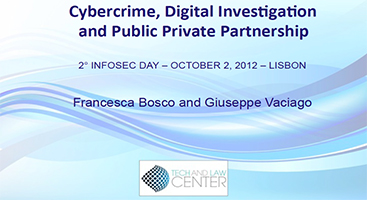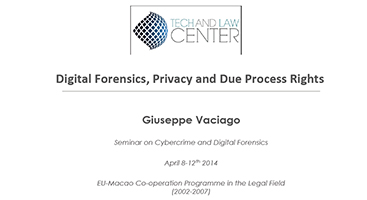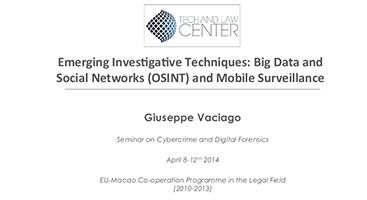Digital tools for crime prevention: has the pre-crime era started
By Marco Mendola
May 2014
On the 27th of March 2014, a famous Italian newspaper “Corriere della Sera” curious article. A serial robber was detected and arrested thanks to the “Key-Crime” software program, developed by the Police of the Headquarters of Milan. The software had analyzed his criminal behavior using an algorithm that crosses hypothesis about human criminal intention, and had indicated he would have perpetrated that crime.
The man was responsible of eleven robberies in different pharmacies since December 2013. The policemen pointed out that he had been using the same strategy for all his criminal actions, using a cover and intimidating the owners with a little knife or with a toy gun.
He was arrested by the Police at Cervignano d’Adda (Lodi), after an attempted robbery in a pharmacy. The policemen had been waiting for him outside the shop and caught him while using his fakegun.
The algorithm used by the software could represent something revolutionary, and for sure an amazing possibility to detect a delinquent and prevent his illegal behavior, however, nothing new under the sky for experts in criminal risk-assessment.
Taking about Pre-crime or Key-Crime, researchers know that this futuristic method have been used many times in the USA from different Police Departments, starting with an experimental approach to follow its concrete development.
It is necessary to explain the common core of this issue. Let’s start!
In the movie Minority Report, adapted from Philip K. Dicks short story of 1956, three mutants called Precogs, were able to predict actions and states of mind of citizens up to the next two weeks with a 99% degree of accuracy. Moreover, they were used by the Department of Pre-crime to arrest and detain would-be offenders before they could get a chance to carry out the
Although the story published in Fantastic Universe was intended to represent a futuristic reality, this is not very far from what is happening.
In 2010 The New York Times had already posted an article that talked about the Police Department in Santa Cruz (California) who had developed software inspired by the Precog’s
Also in the city of Memphis (Tennessee) the study of Pre-crime is growing up, in fact, we can find the “Real Time Crime Center”, 4, adapted from Philip K. Dick’s where it is possible to find topographic maps of the city, HD monitors for a general society surveillance. Fast headlines report notices about crimes in real time, receiving feed-backs from CCTV around the city.
The city of Richmond (Virginia) utilizes as well a particular computer software– called Predictive Policing 2.0 –that monitor every hour, day, week and month to better describe the evolution of the criminal phenomenon, with the intention of re-building faster and more correctly the dynamics of a crime.
What is more, a research from the Memphis Department of Pre-crime, published on the Scientific American in 2012 by J. Vlahos complex, and tracking crime rates back to primary causes remains notoriously difficult.
Predictive strategies such as Memphis’s Blue Crush system. Since 2006, when the Blue Crush was instituted, crimes against property and violence decreased significantly of 26%. Therefore, The National Institute of Justice experimental law program, concerning the utilization of Key-crime software in seven different cities such as Boston, Chicago, New York, Los Angeles and Washington DC.
Computers process a huge amount of data, developing predictive algorithms with a specific process called rule-induction. Thanks to this method, computers are able to calculate a lot of different factors and combination to develop statistic projections for a crime to be committed.
An expert of criminology at the University of Pennsylvania, Prof. Richard Berk developed a new algorithm that estimates the probability with which a person on probation could commit a homicide. This algorithm is based on a review of thousands of cases and accounts variables such as age, sex, type of crime, and the date of the first infraction.
The accurate study of variables such as time and geography into a specific area – supported by digital technologies – constitutes the main factor about pre-crime thinking.
Nevertheless, we can date the pre-crime method since 1990, before the digital revolution had begun.
We are talking about GIS – Geographical information systems- a particular tool widely used to support policing and crime prevention. These were computer-based systems that combined police crime data with spatial location information. This includes mapping patterns of different types of offence, identifying the areas where they occur most frequently and the causal factors as well.
One of the most important input for GIS is geo-coded data, that individuate a very precise geographical information on a street. In any case, these systems cannot give a precise indication of the incidence of all crimes committed, because police records are dependent on the willingness of people to report incidents. Furthermore, the use of such data also raises issues of confidentiality and data sharing.
A typical example for GIS utilization is represented by the case of Canada. The Federal Government with the National Crime Prevention Centre has piloted an analysis of neighborhood crime in six different cities. This system helped to highlight differences in criminal behavior such as youth crime, robbery, and identified travel patterns to commit crime and criminal trends over time.
For all these reasons, on the one hand this scenario could be very useful to understand and prevent crime in our society, on the other hand this possibility open an extraordinary amount of problems related to our social and legal environment.
In simple words the new perspective of crime prevention is represented by an approach based on information of past crime statistics, technology, criminology, predictive algorithms, and the use of these data to improve crime suppression on the streets.
Professor A. Ferguson - University of The District of Columbia – emphasizes that the most relevant and contradictory aspect about this method is the discriminatory use or discriminatory effect on our society.
The relationship between these data and law enforcement could generate a disproportionate effect on certain communities that is perceived as discriminatory.
The adoption of the COMPSTAT program by the New York City Police Department showed that the majority of citizens analyzed were people of color, usually poor and with integration problems. This highlights that while all citizens would like to reduce crime, for some of them in higher rate crime areas, the cost of this reduction in terms of social tension, liberty infringements and physical violence has not always been squarely balanced.
As a consequence, it’s easy to imagine the potential discrimination of particular groups of people targeted using predictive technologies.
Summarizing, the focus is not represented only by the analysis of data based on crime and society, but specifically how and with which perspective those data could be used.
Moreover, the appropriate use of these digital proofs in a trial - respecting fundamental procedural guarantees and following cross examination rules - constitutes the most important challenge for jurists.
Substantially, it sounds really difficult to describe and understand the issue appropriately, this discussion is causing lots of different interpretations first of all in the law system, in particular in the field of constitutional law and criminal procedure law.
As we can see, the utilization of this method to improve crime prevention could be as useful as difficult, in particular in the establishment of an adequate relationship with the fundamental principles of the western legal culture such as the due process of law.
However the Pre-crime revolution has already begun!























